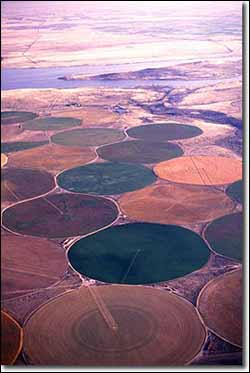Changes in agricultural practices could help slow global warming

More than 100 center-pivot sprinklers controlled by a central computer irrigate wheat, alfalfa, potatoes, and melons along the Columbia River near Hermiston, Oregon. Doug Wilson/ARS
Farmers who plant more crops, increase irrigation coverage and till the land less can have a profound effect on climate.
Climate scientists from Lawrence Livermore National Laboratory found that models that included recent changes in agricultural practices, such as more irrigation, higher yielding crops, and less tillage, predicted lower temperatures than models that ignored these factors.
“Nearly all models used to predict climate changes either ignore agriculture altogether or assume that farmers behave the same way through time,” said David Lobell, the lead author on a paper appearing in the March 23 issue of the journal Geophysical Research Letters. “In reality, farmers are changing rapidly in response to new technologies, growth in demand and other factors. This study suggests that these changes may have important cooling effects, especially at local scales.”
Human activities are widely recognized as contributing to climate change through the burning of fossil fuel and land use activities.
Previous studies had considered the effects of converting natural ecosystems such as forests into croplands. Croplands generally reflect more sunlight than other land covers, and therefore tend to cool local temperatures.
“In our earlier study, we found that historical conversion of forests to croplands had cooled the planet by 0.5 degrees Fahrenheit, and locally by as much as 4 degrees Fahrenheit,” said Livermore’s Govindasamy Bala, co-author of the study.
But past work had neglected changes occurring within existing croplands.
According to the Food and Agricultural Organization, the net increase in global cropland during the last 50 years has been about 10 percent. But in existing cropland, over the same period, farmers have doubled irrigation areas, have more than doubled the crop yields, and have increased the number of crops grown in a field per year. As crops become more productive, more sunlight is reflected. A recent trend toward less frequent plowing of fields also has raised the reflectivity, or albedo, of the surface. Each of these factors can cool local temperatures in the climate model by more than 2 degrees Fahrenheit.
Irrigation cools the surface through a different effect – by increasing the amount of energy used to evaporate water rather than heat the land. The study found that extreme scenarios of irrigation change could cool local temperatures by as much as 10 degrees Fahrenheit, and global average temperatures by 2 degrees Fahrenheit.
The authors of the study, which included Livermore scientist Philip Duffy, caution that the changes in the model were extreme, and effects in the real world are likely smaller. But they identified two main implications of their work.
First, the past effects of global warming in agricultural regions may have been partially masked by changes in farmers’ practices.
“In the context of the ongoing climate change debate, this study clearly shows that a complete documentation of localized natural and human induced changes to the environment will be necessary to understand climate change at the local and regional levels,” said Bala.
“Agricultural regions are some of the key areas where we would like to understand and predict climate changes in order to aid adaptation to global warming,” added Lobell.
Second, the study indicates that climate mitigation policies, which often include incentives to farmers, may be too simplistic. Most proposed climate policies focus only on the ability of farmers to sequester carbon in soils or reduce on-farm energy use.
“This study illustrates that carbon is not the only important way that agriculture affects climate, and so focusing only on carbon may lead to an under- or over-evaluation of agriculture’s role,” Lobell said.
For example, the study estimated that the increased albedo from reduced tillage had roughly as much of a cooling effect on global climate as the increased soil carbon sequestration.
Founded in 1952, Lawrence Livermore National Laboratory has a mission to ensure national security and apply science and technology to the important issues of our time. Lawrence Livermore National Laboratory is managed by the University of California for the U.S. Department of Energy’s National Nuclear Security Administration.
Media Contact
More Information:
http://www.llnl.govAll latest news from the category: Earth Sciences
Earth Sciences (also referred to as Geosciences), which deals with basic issues surrounding our planet, plays a vital role in the area of energy and raw materials supply.
Earth Sciences comprises subjects such as geology, geography, geological informatics, paleontology, mineralogy, petrography, crystallography, geophysics, geodesy, glaciology, cartography, photogrammetry, meteorology and seismology, early-warning systems, earthquake research and polar research.
Newest articles

Bringing bio-inspired robots to life
Nebraska researcher Eric Markvicka gets NSF CAREER Award to pursue manufacture of novel materials for soft robotics and stretchable electronics. Engineers are increasingly eager to develop robots that mimic the…

Bella moths use poison to attract mates
Scientists are closer to finding out how. Pyrrolizidine alkaloids are as bitter and toxic as they are hard to pronounce. They’re produced by several different types of plants and are…

AI tool creates ‘synthetic’ images of cells
…for enhanced microscopy analysis. Observing individual cells through microscopes can reveal a range of important cell biological phenomena that frequently play a role in human diseases, but the process of…





















